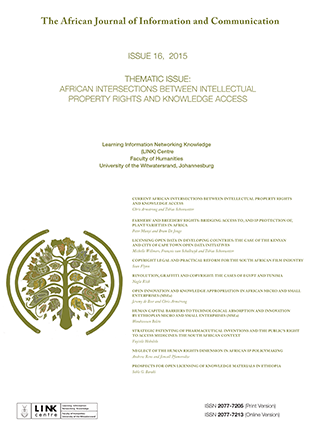Strategic Patenting of Pharmaceutical Inventions and the Public's Right to Access Medicines: The South African Context
DOI:
https://doi.org/10.23962/10539/19317Keywords:
patents, pharmaceuticals, strategic patenting, public interest, access, compulsory licensing, competition, South AfricaAbstract
Pharmaceutical firms' use of strategic patenting to influence the markets within which their patented inventions sit is legally questionable. Such patenting entails filing patents with the intention of blocking potential competitors from innovating and/or being granted patents within niche technology areas of interest to the patentee. Under this practice, patentees are potentially able to extend the breadth and duration of their monopoly power in the pharmaceutical market sub-sector within which that invention sits. Such practices take on a clear public interest element if they undermine affordable public access to medicines. This thematic report outlines forms of strategic patenting, analyses the degree to which the South African legal system provides remedies against such patenting, and proposes ways forward for South Africa to prevent such practices.
References
Abbas, M. Z. (2013). Pros and cons of compulsory licensing: An analysis of arguments. International Journal of Social Science and Humanity, 3(3), 245-258. https://doi.org/10.7763/IJSSH.2013.V3.239
Afrita (Pty) Ltd and Another v Carlton Paper of South Africa (Pty) Ltd, 1992 BP 331 (BP).
Bader, M. A., Gassmann, O., Ziegler, N., & Ruether, F. (2012). Getting the most out of your intellectual property - patent management along its life cycle. Drug Discovery Today, 17(7), 281-284. https://doi.org/10.1016/j.drudis.2011.10.025
Burrell, T. D. (1999). Burrell's South African patent and design law (3rd ed.). Durban: Butterworths.
Correa, C. M. (2007). Compulsory licensing: How to gain access to patented technology. In A. Krattiger (Ed.), ipHandbook of best practices. Retrieved from http://www.iphandbook.org/handbook/ch03/p10.
Correa, C. M. (2011). Pharmaceutical innovation, incremental patenting and compulsory licensing. South Centre Research Paper 41. Geneva: South Centre.
Delta G Scientific (Pty) Ltd v Janssen Pharmaceutica NV and Another, 1996 BP 455 (CP).
Department of Trade and Industry (DTI), (2013). Draft National Policy on Intellectual Property. Government of South Africa. Pretoria: General Notice 918 of 2013, 13 September.
Dolfsma, W. (2011). Patent strategizing. Journal of Intellectual Capital, 12(2), 168-178. https://doi.org/10.1108/14691931111123377
Guellec, D., Martinez, C., & Zuniga, P. (2013). Pre-emptive patenting: Securing market exclusion and freedom of operation. Economics of Innovation and New Technology, 21(1), 1-29. https://doi.org/10.1080/10438599.2010.536378
Hazel Tau & Others v GlaxoSmithKline and Boehringer Ingelheim, Competition Commission Case No. 2002Sep226.
Jackson, P. J. (2007). The dangers of patents as weapons. LLM thesis. Canterbury, UK: University of Kent.
Kapczynski, A., Park, C., & Sampat, B. (2012). Polymorphs and prodrugs and salts (Oh My!): An empirical analysis of "secondary" pharmaceutical patents. PLoS ONE, 7(12). https://doi.org/10.1371/journal.pone.0049470
Krishnan, R., & Balachandran, V. (2014).TRIPS Agreement and product patent - some issues. International Journal of Advanced Research in Management and Social Sciences, 3(4), 175-183.
Novartis AG v Union of India (UOI) and Others; Natco Pharma Ltd. v UOI and Others; M/S Cancer Patients Aid Association v. UOI and Others, Civil Appeal No. 2706-2716 of 2013.
Paris Convention for the Protection of Industrial Property of 1883, as last amended 28 September 1979.
Republic of South Africa (RSA). (1978). Patents Act of 57 of 1978, as last amended 15 January 2013.
Republic of South Africa (RSA). (1998). Competition Act 89 of 1998, as last amended 3 June 2013.
Sanachem (Pty) Ltd v British Technology Group plc, 1992 BP 276 (CP).
Sople, V. V. (2012). Managing intellectual property: The strategic imperative (3rd ed.). New Delhi: PHI Learning.
Sternitzke, C. (2013). An exploratory analysis of patent fencing in pharmaceuticals: The case of PDE5 inhibitors. Research Policy, 42(2), 542-551. https://doi.org/10.1016/j.respol.2012.11.003
Syntheta (Pty) Ltd previously Delta G Scientific (Pty) Ltd v Janssen Pharmaceutica NV and Another, (449/96) [1998] ZASCA 74; 1999 (1) SA 85 (SCA); [1998] 4 All SA 445 (A).
Wang, R. L. (2014). Ancillary orders of compulsory licensing and their compatibility with the TRIPS Agreement. Marquette Intellectual Property Law Review, 18(1), 88-105. https://doi.org/10.1007/978-3-642-54704-1_10
World Trade Organisation (WTO). (1994). Agreement on Trade-Related Aspects of Intellectual Property Rights (TRIPS).
Yang, D. (2012). Compulsory licensing: For better or for worse, the done deal lies in the balance. Journal of Intellectual Property Rights, 17(1), 76-81.
Downloads
Published
Issue
Section
License
Copyright (c) 2015 https://creativecommons.org/licenses/by/4.0

This work is licensed under a Creative Commons Attribution 4.0 International License.
How to Cite
- Abstract 329
- pdf 144


.png)